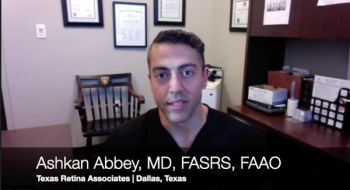
Trabeculectomy may have differential effects in glaucoma field loss
Regional rather than global analysis of visual fields may produce more precise assessments of glaucomatous progression following trabeculectomy, since the surgery seems to have differential effects.
Take-home:
Regional rather than global analysis of visual fields may produce more precise assessments of glaucomatous progression following trabeculectomy, since the surgery seems to have differential effects.
By Nancy Groves
Los Angeles-Measuring change in perimetric rates to monitor patients with glaucoma following trabeculectomy has a number of challenges.
One way, however, of overcoming these challenges is to use regional measures rather than perform global analysis of the visual field, said Joseph Caprioli, MD, FACS.
“It seems that trabeculectomy exerts differential effects that can go in opposite directions on component rates of visual fields,” said Dr. Caprioli, who is the David May II Professor of Ophthalmology, UCLA School of Medicine, and chief, Glaucoma Division, Jules Stein Eye Institute. “If you look at the entire field for each patient, it’s hard to find improvement or worsening, and sometimes it’s hard to find progression.
“But if you look at the different component rates, you’re culling out the signal, which then rises above the variability and noise of the field, and you can see some of these effects,” he added.
Trabeculectomy tends to protect that portion of the visual field that is getting worse from glaucoma, slowing but not stopping the progression. At the same time, it slightly worsens the portion that is not manifestly damaged by glaucoma, he said.
Dr. Caprioli explained his findings on the differential effects of trabeculectomy based on a study in which patients had been followed on average 5 years both before and after surgery, providing the large amount of data necessary for this type of analysis. Regional rates of field loss were determined by performing either exponential or linear trend analysis at each point in the visual field.
All points were divided into two groups:
- Those that were getting worse very slowly.
- Those that had a faster rate of decay.
Rates of visual field loss
Analysis showed a large reduction in the fast rate and a much smaller increase in the slow rate. This is consistent with a reduced rate of glaucoma damage, which is more focal and localized, and an increase in cataract media, which is slower and more diffuse, Dr. Caprioli said.
The study group consisted of 83 eyes of 73 patients with follow-up of 5.5 ± 2.6 years before surgery and 5.7 ± 2.6 years after. The mean number of visual fields before surgery was 9.9 ± 6.3 and 10.2 ± 4.9 postoperatively.
The patients as a whole did not have advanced glaucoma; the initial and final mean deviations were –6 ± 5.8 dB and 1 ± 7.5 dB, respectively.
Patients achieved about a 30% decrease in both mean and peak IOP following trabeculectomy. Mean IOP was 15.3 ± 2.8 mm Hg preoperatively and 10.3 ± 3.3 mm Hg postoperatively. Peak IOP before surgery reached 20.1 ± 5 mm Hg versus 13.9 ± 4.8 mm Hg after.
In all eyes, the cluster of fast-progressing points deteriorated at a rate of 32% per year preoperatively but only 5% following the procedure.
While there was no deterioration in the slow components before trabeculectomy, it occurred at a rate of 5% a year after, apparently due to cataract. Analyzing only eyes that were pseudophakic at the beginning of follow-up, the glaucoma behavior was about the same, but the slow component worsened at a lower rate, only 2% a year.
Acute reversal
One of the important discoveries from the study was that an element of acute reversal was apparent.
“The reversal is in the fast component only,” Dr. Caprioli said. “It is relatively common, but can only be recognized as a common event if you focus on the cluster of points that is most rapidly changing and is most affected by the glaucoma.
“We like to think that this is a function of sick but not dead retinal ganglion cells,” he added. “If there is a population of cells that aren’t quite functioning but still alive and you relieve the stress on those cells, it’s possible that they can start to function again.”
These important differential effects are masked when global indices-such as mean deviation and visual field index-are used to monitor surgical outcome measures, he noted.
“We really need to use regional measures to look at the effects of glaucoma treatment more meaningfully,” Dr. Caprioli concluded.
Joseph Caprioli, MD, FACS
P: 310/794-9442
E:
Dr. Caprioli has received grant support from Alcon Laboratories, Allergan, New World Medicine, National Institutes of health/National Eye Institute, and Research to Prevent Blindness. He is also a consultant for Allergan.
Newsletter
Don’t miss out—get Ophthalmology Times updates on the latest clinical advancements and expert interviews, straight to your inbox.





















































.png)


